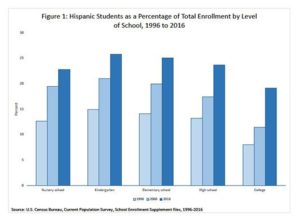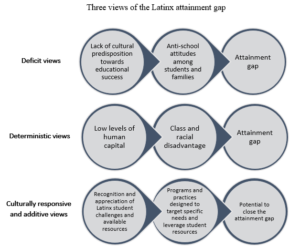Recent NYKids Article Addresses the Latinx Attainment Gap
By Aaron Leo & Kristen C. Wilcox
The Latinx student population residing in the United States tripled between 1980 and the end of the 20th century; currently one in four students in U.S. schools identify as Latinx (see chart below).
 Despite two decades of progress, Latinx students are at a highest risk of high school dropout and less likely than other student subgroups to possess a college degree. Though Latinx high school graduates are now enrolling in colleges at a historically high rate, low completion rates suggest that many students are confronting obstacles upon entry into postsecondary contexts.
Despite two decades of progress, Latinx students are at a highest risk of high school dropout and less likely than other student subgroups to possess a college degree. Though Latinx high school graduates are now enrolling in colleges at a historically high rate, low completion rates suggest that many students are confronting obstacles upon entry into postsecondary contexts.
Some explanations for the Latinx attainment gap utilize deficit orientations that lay blame on individuals, their families, or their cultures. Others emphasize low levels of human capital and discrimination, which can hamper the educational performance of immigrants and their descendants. Such frameworks fail to account for academically successful Latinx youth as well as the potential for educators to effect more positive outcomes among minority students.
In a recent article published by the Journal of Latinos and Education, NYKids team members explore the Latinx attainment gap and argue for the positive impact that culturally responsive approaches can have on these students. We draw on our study of odds-beating schools to demonstrate the effectiveness of these practices.
The Myths of and Determinism to Explain the Latinx Attainment Gap
Some theorists have used a deficit perspective to explain the differential academic performances of Latinx students. They characterize Latinx students as lacking the cultural or individual dispositions needed to excel in school and as unwilling or unable to acculturate to mainstream American norms that would provide them with educational success and social mobility. However, this perspective ignores the impacts of racial discrimination and class disparities while contributing to the myth that Latinx students and their families do not value education.
Other scholars have explained the Latinx attainment gap by emphasizing the impacts of class disparities and racial discrimination. For example, Latinx students are more likely than any other student subgroup to attend under-resourced, highly segregated schools with large class sizes and underqualified teachers. Moreover, a large proportion of Latinx students are the first in their families to attend college and therefore may not have a full understanding of the college and financial aid process. Lastly, have shown that the cultural and linguistic resources of Latinx students are often overlooked or viewed as impediments to their success. These findings reflect educational policies that privilege monolingualism and assimilation.
However, such studies often fail to acknowledge the impact that effective educational practices can have on Latinx students and instead view these disadvantages as deterministically producing disparities. As shown below, culturally responsive approaches can help ameliorate the Latinx attainment gap while providing an alternative view on its existence.
The Promise of Culturally Responsive Approaches in Odds-Beating Schools
 As explored in previous NYKids blogs, culturally responsive approaches to educating minority students holds great promise for closing attainment gaps. Rather than calling attention to what Latinx students and their families lack, culturally responsive frameworks seek to build from the knowledge and resources of minority students to effect positive outcomes. This perspective also acknowledges the responsibility of schools to ameliorate academic disparities.
As explored in previous NYKids blogs, culturally responsive approaches to educating minority students holds great promise for closing attainment gaps. Rather than calling attention to what Latinx students and their families lack, culturally responsive frameworks seek to build from the knowledge and resources of minority students to effect positive outcomes. This perspective also acknowledges the responsibility of schools to ameliorate academic disparities.
Our findings from odds-beating schools with large Latinx student populations (Freeport High School and Port Chester High School) challenge deficit perspectives while demonstrating the effectiveness of culturally responsive approaches in closing attainment gaps for Latinx students.
In particular we found five approaches that educators at odds-beating schools utilize to help close attainment gaps and promote college-readiness in their Latinx student populations.
Identifying the Particular Challenges Facing Latinx Students
Educators seek to understand and acknowledge the unique challenges that Latinx students face. This close attention to students’ lives both inside and outside of school provided educators with a responsive and empathetic perspective that was key to developing effective approaches to educating Latinx students. As a teacher from Port Chester explained:
[Latinx students] face many challenges that sometimes prevent them from being able to achieve that, like having to work after school, being in this country for the first time, living with relatives that they’ve never met until they’ve come here, or reacquainting themselves with their parents after sometimes more than a decade of not being with their parents; just the whole shock of being in this country and in a new school system and all of that.
Making Accommodations to the Needs of Latinx Students
Educators at odds-beating schools not only acknowledge the particular challenges faced by their Latinx student population but also have developed specialized approaches to attend to those needs. Such practices include creating “safety nets” for new arrivals, evening high school classes for those who may be working during the day, and vocational options for students through BOCES. In the words of a school leader from Freeport:
And then [newly arrived Latinx youth] are thrust into a new high school with a new language and are expected to perform academically. And unless we, as an institution, understand that we have to service the whole child and not just make sure they pass a test and graduate, we’re not going to find continued success.
Rejecting Deficit Perspectives and Setting High Expectations for Latinx Students
Deficit perspectives were explicitly and ardently rejected by educators who set high expectations for their Latinx student population. For instance, accommodations to assist Latinx students do not entail a decline in rigor or expectations, and, in fact, educators described how they seek to ensure Latinx students are not simply passing classes but are ready for their “next steps” after high school. As the superintendent of Port Chester put it:
I think that a couple of things have taken place here at the high school which have really changed the dial. First, the . . . the recalibration of the expectations of what our [Latinx students] are capable of as indicated by the implementation of programs like the IB program. You know, “Oh, you’re a 74% percent Hispanic high school; how are you going to have a successful IB program?”
Utilizing Culturally Responsive Approaches to Pedagogy and Curriculum
 Educators at Freeport and Port Chester use culturally responsive pedagogies that validate Latinx students’ knowledge and experiences by meaningfully incorporating these aspects into curricula and promoting the goal of utilizing classroom learning in their everyday lives. Such practices validate students’ cultural and linguistic identities as curricular resources. English Language Arts (ELA) teachers at Port Chester, for example, described the process of making their classes more “relatable” to their Latinx students. The emphasis, as one teacher explained, is to have students be able to apply classroom knowledge outside of school:
Educators at Freeport and Port Chester use culturally responsive pedagogies that validate Latinx students’ knowledge and experiences by meaningfully incorporating these aspects into curricula and promoting the goal of utilizing classroom learning in their everyday lives. Such practices validate students’ cultural and linguistic identities as curricular resources. English Language Arts (ELA) teachers at Port Chester, for example, described the process of making their classes more “relatable” to their Latinx students. The emphasis, as one teacher explained, is to have students be able to apply classroom knowledge outside of school:
Our overarching idea is something within, an issue within society, but then having [Latinx students] direct that based on what that means to them and within their own community or in their own views and how that applies.
Prioritizing the Hiring of Culturally and Linguistically Diverse Staff Members
Staffing choices reflect culturally responsive attitudes, as educators with bilingual abilities or a background in working with diverse student populations are sought after by school and district leaders. For instance, at Freeport High School, bilingual guidance counselors have been hired to assist Spanish-speaking students and connect with their families. As a teacher explained:
In previous years . . . the students would come to us and say, “Well my guidance counselor doesn’t speak Spanish, so I don’t know what they’re talking about.” Now we don’t get that anymore – now they know who to go to. The [counselors] are bilingual, they speak Spanish, and they understand [the student’s] path, and that’s huge.
 The approaches evident at these odds-beating schools demonstrate the power and potential of cultural responsiveness in practice. In dispelling deficit and deterministic theories that blame Latinx students and their families for educational disparities, these findings also illustrate the power and potential of schools to produce positive outcomes for Latinx youth.
The approaches evident at these odds-beating schools demonstrate the power and potential of cultural responsiveness in practice. In dispelling deficit and deterministic theories that blame Latinx students and their families for educational disparities, these findings also illustrate the power and potential of schools to produce positive outcomes for Latinx youth.
For more on this topic, read our full manuscript online at the Journal of Latinos and Education. Please continue to follow NYKids’ News and view our Research Results for more information on the strategies used by educators at odds-beating We welcome your feedback and suggestions at nykids@albany.edu.
